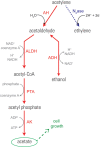Acetylenotrophy: a hidden but ubiquitous microbial metabolism?
- PMID: 29933435
- PMCID: PMC7190893
- DOI: 10.1093/femsec/fiy103
Acetylenotrophy: a hidden but ubiquitous microbial metabolism?
Abstract
Acetylene (IUPAC name: ethyne) is a colorless, gaseous hydrocarbon, composed of two triple bonded carbon atoms attached to hydrogens (C2H2). When microbiologists and biogeochemists think of acetylene, they immediately think of its use as an inhibitory compound of certain microbial processes and a tracer for nitrogen fixation. However, what is less widely known is that anaerobic and aerobic microorganisms can degrade acetylene, using it as a sole carbon and energy source and providing the basis of a microbial food web. Here, we review what is known about acetylene degrading organisms and introduce the term 'acetylenotrophs' to refer to the microorganisms that carry out this metabolic pathway. In addition, we review the known environmental sources of acetylene and postulate the presence of an hidden acetylene cycle. The abundance of bacteria capable of using acetylene and other alkynes as an energy and carbon source suggests that there are energy cycles present in the environment that are driven by acetylene and alkyne production and consumption that are isolated from atmospheric exchange. Acetylenotrophs may have developed to leverage the relatively high concentrations of acetylene in the pre-Cambrian atmosphere, evolving later to survive in specialized niches where acetylene and other alkynes were produced.
Figures





Similar articles
-
Acetylenotrophic and Diazotrophic Bradyrhizobium sp. Strain I71 from TCE-Contaminated Soils.Appl Environ Microbiol. 2022 Nov 22;88(22):e0121922. doi: 10.1128/aem.01219-22. Epub 2022 Oct 26. Appl Environ Microbiol. 2022. PMID: 36286524 Free PMC article.
-
Acetylene as fast food: implications for development of life on anoxic primordial Earth and in the outer solar system.Astrobiology. 2008 Feb;8(1):45-58. doi: 10.1089/ast.2007.0183. Astrobiology. 2008. PMID: 18199006
-
Acetylene-Fueled Trichloroethene Reductive Dechlorination in a Groundwater Enrichment Culture.mBio. 2021 Feb 2;12(1):e02724-20. doi: 10.1128/mBio.02724-20. mBio. 2021. PMID: 33531396 Free PMC article.
-
Soil microorganisms as controllers of atmospheric trace gases (H2, CO, CH4, OCS, N2O, and NO).Microbiol Rev. 1996 Dec;60(4):609-40. doi: 10.1128/mr.60.4.609-640.1996. Microbiol Rev. 1996. PMID: 8987358 Free PMC article. Review.
-
Biogeochemistry of dihydrogen (H2).Met Ions Biol Syst. 2005;43:9-48. doi: 10.1201/9780824751999.ch2. Met Ions Biol Syst. 2005. PMID: 16370113 Review.
Cited by
-
Got acetylene: a personal research retrospective.FEMS Microbes. 2021 Jul 31;2:xtab009. doi: 10.1093/femsmc/xtab009. eCollection 2021. FEMS Microbes. 2021. PMID: 37334230 Free PMC article.
-
Complete Genome Sequence of Rhodococcus opacus Strain MoAcy1 (DSM 44186), an Aerobic Acetylenotroph Isolated from Soil.Microbiol Resour Announc. 2022 Jan 20;11(1):e0081421. doi: 10.1128/MRA.00814-21. Epub 2022 Jan 6. Microbiol Resour Announc. 2022. PMID: 34989600 Free PMC article.
-
Formation and Stability of the Propionitrile:Acetylene Co-Crystal Under Titan-Relevant Conditions.ACS Earth Space Chem. 2025 Jan 28;9(2):253-264. doi: 10.1021/acsearthspacechem.4c00262. eCollection 2025 Feb 20. ACS Earth Space Chem. 2025. PMID: 40008142 Free PMC article.
-
Syntrophotalea acetylenivorans sp. nov., a diazotrophic, acetylenotrophic anaerobe isolated from intertidal sediments.Int J Syst Evol Microbiol. 2019 Jun;71(3):004698. doi: 10.1099/ijsem.0.004698. Epub 2021 Feb 11. Int J Syst Evol Microbiol. 2019. PMID: 33570486 Free PMC article.
-
Acetylenotrophic and Diazotrophic Bradyrhizobium sp. Strain I71 from TCE-Contaminated Soils.Appl Environ Microbiol. 2022 Nov 22;88(22):e0121922. doi: 10.1128/aem.01219-22. Epub 2022 Oct 26. Appl Environ Microbiol. 2022. PMID: 36286524 Free PMC article.
References
-
- Abbas O, Schulze-Makuch D. Acetylene-based pathways for prebiotic evolution on Titan. In: Lacoste H. (ed). Proceedings of the First European Workshop on Exo-Astrobiology, ESA SP-518 Graz, Austria: ESA Publications Division, 2002, 345–8.
-
- Arnold WA, Roberts AL. Pathways and kinetics of chlorinated ethylene and chlorinated acetylene reaction with Fe(0) particles. Environ Sci Technol. 2000;34:1794–805.
-
- Atkinson R, Baulch DL, Cox RA et al. . Evaluated kinetic and photochemical data for atmospheric chemistry: supplement VI. IUPAC subcommittee on gas kinetic data evaluation for atmospheric chemistry. J Phys Chem Ref Data. 1997;26:1329–499.
-
- Baker AK, Beyersdorf AJ, Doezema LA et al. . Measurements of nonmethane hydrocarbons in 28 United States cities. Atmos Environ. 2008;42:170–82.
Publication types
MeSH terms
Substances
Grants and funding
LinkOut - more resources
Full Text Sources
Other Literature Sources
Molecular Biology Databases

